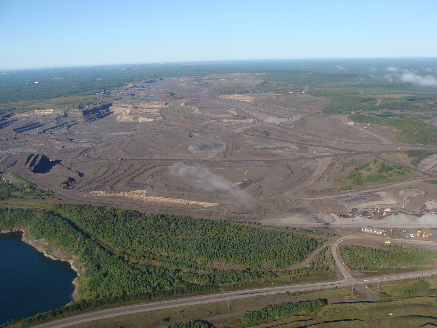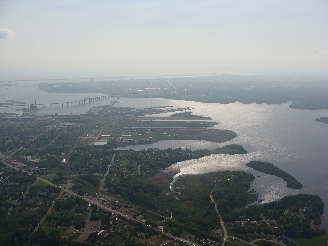Because all things are connected, the 1854 Treaty Authority is charged with protecting the health of the environment. Natural resources must be safe for current treaty rights harvest and available for future generations and therefore we must work together to preserve and protect the air, water and land.
ENVIRONMENTAL REVIEW
While not opposed to economic development, the 1854 Treaty Authority is tasked with ensuring that land management and industrial activities are done with minimal impact to the rich natural and cultural resources in the 1854 Ceded Territory. We remain involved in early and meaningful consultation on projects that might affect the health of the environment. This includes the environmental review of activities like mining of precious metals, taconite (iron ore) mining, power generation, land management (timber cuts, habitat restoration, public access, etc.), general development (roads, buildings, etc.), gas/oil pipeline placement/replacement and changes to public land ownership.
The 1854 Treaty Authority also weighs in on policies that have resulting impacts to the natural world. Representing the interest of the bands we serve, we provide input on the development and enforcement of water quality standards from commercial, industrial and municipal water discharge. We are most concerned with how discharge might affect traditionally utilized waterways, like wild rice waters or fishery resources. We remain involved in providing input to the Minnesota Pollution Control Agency (MPCA) as they consider changes to the wild rice water quality standard for sulfate. See the MPCA website for more information on this topic.
NATURAL RESOURCE DAMAGE ASSESSMENT
Industrial projects can leave a lasting impact on the environment. A Natural Resource Damage Assessment (NRDA) is the legal process that federal agencies, together with states and tribes, use to evaluate the impacts of industrial projects (oil spills, hazardous waste sites, and ship groundings) on natural resources both along the nation's coast and throughout its interior. When negative impacts have been identified, companies may be required to compensate the public for lost natural resource services. The 1854 Treaty Authority works with other natural resource trustees (federal, tribal and state agencies) through this process to determine necessary restoration of these resources. For instance, there are sites within the St. Louis River estuary in Duluth with completed or ongoing NRDA processes. For the St. Louis River Interlake Duluth Tar site, also known as Stryker Bay, the site cleanup is complete, an NRDA settlement was reached and restoration projects are ongoing. For the U.S. Steel remediation at Spirit Lake where the cultural monument Spirit Island is located, the NRDA process and site cleanup are ongoing.
 ENVIRONMENTAL QUALITY MONITORING
ENVIRONMENTAL QUALITY MONITORING
Not all of our environmental work is done in meetings and board rooms. Environmental staff gather data through ongoing monitoring activities such as water sampling from areas throughout the 1854 Ceded Territory. Areas include wild rice lakes and/or waters downstream of industrial discharge. Analysis results show changes in water quality over time or impacts from discharge. Staff also cooperate with other agencies in watershed assessment and protections activities.
Contaminants in fish, such as mercury, has been a big concern for band members who harvest and consume fish in the 1854 Ceded Territory. Mercury is a heavy metal that can be toxic to people and the environment. Concentrations in fish increase/magnify as they eat other fish/organisms with mercury (bioaccumulation). As people eat fish, especially predatory fish like walleye, mercury concentrations bioaccumulate further and can impact health. Staff have sampled fish species from select waters within the Ceded Territory to monitor concentrations. This type of information can be used to inform safe consumption of fish, specific to certain waters. In years 2015 – 2018, staff sampled walleye and smallmouth bass from 12 of the spring/fall walleye population assessment lakes to compare mercury concentrations within lakes and between lakes (Analysis of Walleye and Smallmouth Bass Tissues for Mercury in Twelve 1854 Ceded Territory Lakes).
LAKE SUPERIOR PARTNERSHIP 
The 1854 Treaty Authority is also involved with initiatives facing Gichi Gami. Formerly The Lake Superior Binational Program, the Lake Superior Partnership is a conglomerate of federal, tribal, state and Canadian agencies from around the lake that work together on issues within the basin. Through lots of communication, coordination, planning and prioritization, the organization develops five-year Lakewide Action and Management Plans (LAMPs) for Lakes Superior. The LAMPs set priorities and goals for projects that partners undertake in specific areas of the Lake Superior basin. The Partnership is nearly finished with implementing the 2015 - 2019 LAMP and is currently developing the LAMP for years 2020 - 2024. The Lake Superior Lakewide Action and Management Plan Annual Report (2020) was developed by the Lake Superior Partnership and highlights accomplishments and progress made in 2020 on Lake Superior including outreach, monitoring, and protection and restoration action.

